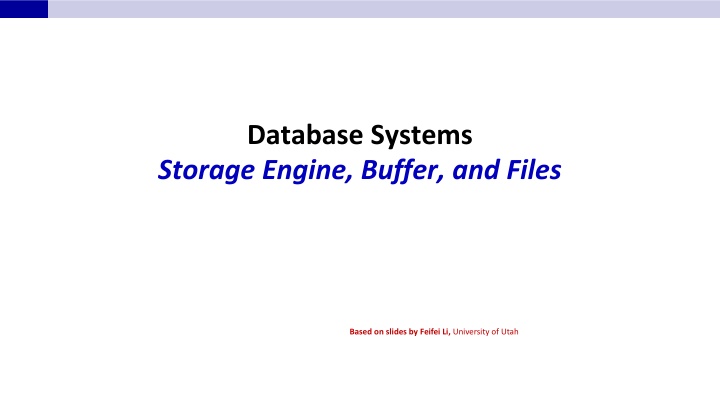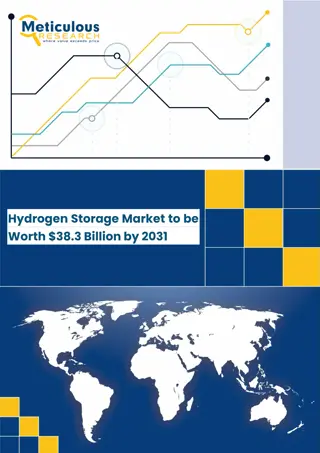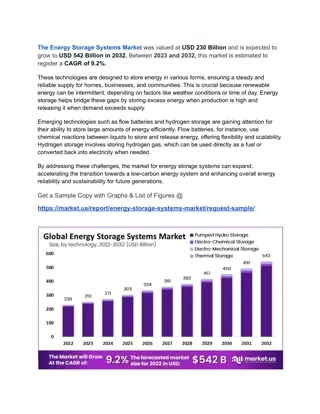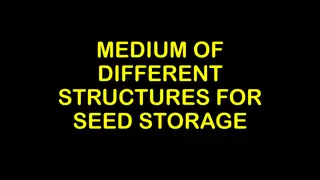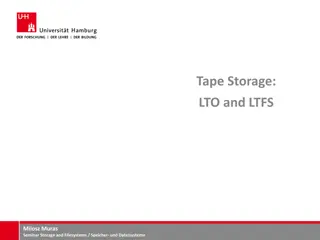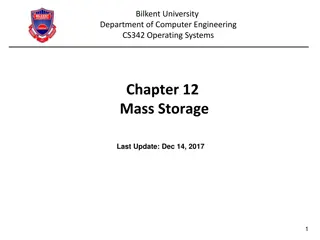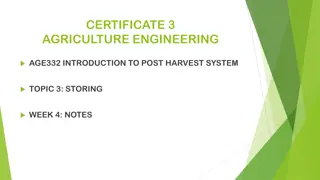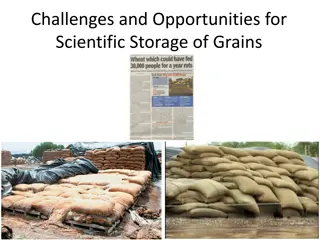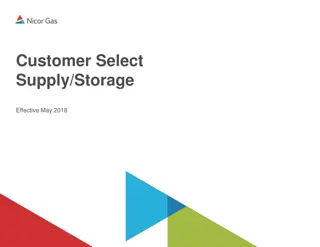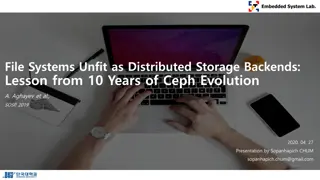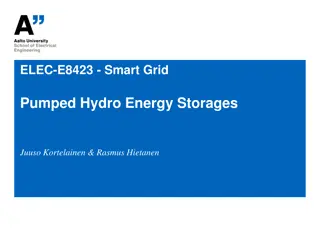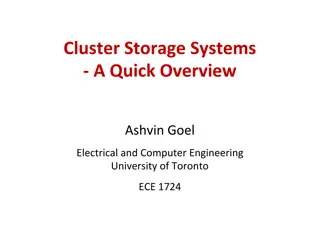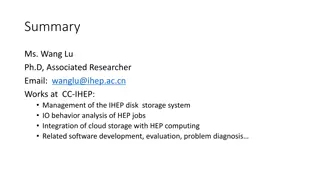Efficient Storage Systems Overview
This content provides an overview of database storage systems, memory hierarchy, data organization, and efficient storage media. It covers topics like storage engines, buffer management, relational models, and memory storage techniques.
Download Presentation

Please find below an Image/Link to download the presentation.
The content on the website is provided AS IS for your information and personal use only. It may not be sold, licensed, or shared on other websites without obtaining consent from the author.If you encounter any issues during the download, it is possible that the publisher has removed the file from their server.
You are allowed to download the files provided on this website for personal or commercial use, subject to the condition that they are used lawfully. All files are the property of their respective owners.
The content on the website is provided AS IS for your information and personal use only. It may not be sold, licensed, or shared on other websites without obtaining consent from the author.
E N D
Presentation Transcript
Database Systems Storage Engine, Buffer, and Files Based on slides by Feifei Li, University of Utah
Now Something Different What is Systems ? A: Not Programming Not programming big things.. Systems = Efficient and safe use of limited resources (e.g., disks) Efficient: resources should be shared, utilized as much as possible Safe: sharing should not corrupt work of individual jobs 2
General Overview Relational model - SQL Formal & commercial query languages Functional Dependencies Normalization Physical Design Indexing Query evaluation Query optimization . Application Oriented Systems Oriented 3
Data Organization Storage Media Memory hierarchy Efficient/reliable transfer of data between disks and main memory Hardware techniques (RAID disks) Software techniques (Buffer management) Storage strategies for relation-file organization Representation of tuples on disks Storage of tuples in pages, clustering. 4
Memory Hierarchy CPU Typical Computer ... ... C M Secondary Storage 5
Storage Media: Players Cache fastest and most costly form of storage; volatile; managed by the computer system hardware. Main memory: fast access (10s to 100s of nanoseconds; 1 nanosecond = 10 9 seconds) generally not big enough (or too expensive) to store the entire database Volatile contents of main memory are usually lost if a power failure or system crash occurs. But CPU operates only on data in main memory 6
Storage Media: Players Disk Primary medium for the long-term storage of data; typically stores entire database. random-access possible to read data on disk in any order, unlike magnetic tape Non-volatile: data survive a power failure or a system crash, disk failure less likely than them Sequential access vs. Random access (more on this later) 7
Storage Media: Players Solid State Drive (aka flash disk) non-volatile Writes are expensive (Erasure block) Random reads are almost as efficient as sequential reads More expensive than disks ($/byte) Tapes Sequential access (very slow) Cheap, high capacity 8
Memory Hierarchy cache Main memory Volatile Non-volatile SSD Hard Disk Tapes Traveling the hierarchy: 1. speed ( higher=faster) 2. cost (lower=cheaper) 3. volatility (between MM and Disk) 4. Data transfer (Main memory the hub ) 5. Storage classes (P=primary, S=secondary, T=tertiary) 9
Memory Hierarchy Data transfers cache mm : OS/hardware controlled (main memory DBMS starts controlling this as well) mm disk : <- reads, -> writes controlled by DBMS mm SSD disk SSD disk Tapes 10
Random Access Machine Model R A M Constant-cost for accessing a memory address anywhere from the memory Standard theoretical model of computation: Infinite memory Uniform access cost Simple model crucial for success of computer industry 11
Hierarchical Memory R A M L 1 L 2 Modern machines have complicated memory hierarchy Levels get larger and slower further away from CPU Data moved between levels using large blocks 12
Slow I/O (Input/Output) Disk access is 106 times slower than main memory access read/write arm track 4835 1915 5748 4125 magnetic surface Disk systems try to amortize large access time transferring large contiguous blocks of data (8-16Kbytes) Important to store/access data to take advantage of blocks (locality) 13
Main memory -- Disk Data Transfers Concerns: Efficiency (speed) can be improved by... a. improving raw data transfer speed b. avoiding untimely data transfer c. avoiding unnecessary data transfer Safety (reliability, availability) can be improved by... a. storing data redundantly 14
Main memory -- Disk Data Transfers Achieving efficiency: Improve Raw data Transfer speed Faster Disks Parallelization (RAID) Avoiding untimely data Transfers Disk scheduling Batching Avoiding unnecessary data xfers Buffer Management Good file organization 15
Disks, Memory, and Files The BIG picture Query Optimization and Execution Relational Operators Files and Access Methods Buffer Management Disk Space Management DB 16
Disks and Files DBMS stores information on disks. In an electronic world, disks are a mechanical anachronism! This has major implications for DBMS design! READ: transfer data from disk to main memory (RAM). WRITE: transfer data from RAM to disk. Both are high-cost operations, relative to in-memory operations, so must be planned carefully! 17
Why Not Store Everything in Main Memory? Costs too much Main memory is volatile. We want data to be saved between runs. (Obviously!) Typical storage hierarchy: Main memory (RAM) for currently used data. Disk for the main database (secondary storage). Tapes for archiving older versions of the data (tertiary storage) 18
Solution 1: Buy More Memory Expensive (Probably) not scalable Growth rate of data is higher than the growth of memory 19
Disks Secondary storage device of choice. Main advantage over tapes: random access vs. sequential. Data is stored and retrieved in units called disk blocks or pages. Unlike RAM, time to retrieve a disk block varies depending upon location on disk. Therefore, relative placement of blocks on disk has major impact on DBMS performance! 20
Components of a Disk Spindle The platters spin (say, 120 rps). Tracks Disk head The arm assembly is moved in or out to position a head on a desired track. Tracks under heads make a cylinder (imaginary!). Sector Only one head reads/writes at any one time. Platters Arm movement Block size is a multiple of sector size (which is fixed). Arm assembly 22
Components of a Disk Read-write head Positioned very close to the platter surface (almost touching it) Surface of platter divided into circular tracks Each track is divided into sectors. A sector is the smallest unit of data that can be read or written. To read/write a sector disk arm swings to position head on right track platter spins continually; data is read/written as sector passes under head Block: a sequence of sectors Cylinder i consists of ith track of all the platters 23
Components of a Disk Typical Values Diameter: Cylinders: Surfaces: (Tracks/cyl): a few 30 Sector Size: Capacity: 1 inch 15 inches 100 2000 1 or 2 512B 50K 100s GB a few TB 24
Accessing a Disk Page Time to access (read/write) a disk block: seek time (moving arms to position disk head on track) rotational delay (waiting for block to rotate under head) transfer time (actually moving data to/from disk surface) Seek time and rotational delay dominate. Seek time varies between about 0.3 and 10msec Rotational delay varies from 0 to 6msec Transfer rate around .008msec per 8K block Key to lower I/O cost: reduce seek/rotation delays! Hardware vs. software solutions? 25
Example ST3120022A : Barracuda 7200.7 Capacity:120 GB Interface: Ultra ATA/100 RPM: 7200 RPM (Rotation per Minute) Seek time: 8.5 ms avg Latency time?: 7200/60 = 120 rotations/sec 1 rotation in 8.3 ms => So, Av. Latency = 4.16 ms 26
Arranging Pages on Disk `Next block concept: blocks on same track, followed by blocks on same cylinder, followed by blocks on adjacent cylinder Blocks in a file should be arranged sequentially on disk (by `next ), to minimize seek and rotational delay. For a sequential scan, pre-fetching several pages at a time is a big win! 27
Random vs sequential i/o Ex: 1 KB Block Random I/O: 15 ms. Sequential I/O: 1 ms. Rule of Thumb Sequential I/O: Much less ~10-20 times Random I/O: Expensive 28
iotrace of sdb for dd-rr (rr is a random read workload) Fewer requests from RR are served when dd was running.
iotrace of sdb for dd-2rr Sequential IOs become almost random!!!
Disk Space Management Lowest layer of DBMS software manages space on disk (using OS file system or not?). Higher levels call upon this layer to: allocate/de-allocate a page read/write a page Best if a request for a sequence of pages is satisfied by pages stored sequentially on disk! Responsibility of disk space manager. Higher levels don t know how this is done, or how free space is managed. Though they may assume sequential access for files! Hence disk space manager should do a decent job. 34
Context Query Optimization and Execution Relational Operators Files and Access Methods Buffer Management Disk Space Management DB 35
Before we go there: How do you store a table? one row at a time 36
how to efficiently access data? how to retrieve rows: if I am interested in the average GPA of all students? if I am interested in the GPA of student A? 37
how to efficiently access data? Scan the whole table if I am interested in most of the data 38
how to efficiently access data? how to retrieve rows: if I am interested in the average GPA of all students? if I am interested in the GPA of student A? 39
how to efficiently access data? Ask an oracle to tell me where is my data if I am interested in a single row 40
how to efficiently access data? what is an oracle or index? a data structure that given a value (e.g., student id) returns location (e.g., row id or a pointer) with less than O(n) cost ideally O(1)! e.g., B Tree, bitmap, hash index 41
how to physically store data? is there another way? columns first one row at a time 42
how to efficiently access data? rows first columns first if I want to read an entire single row? if I want to find the name of the younger student? if I want to calculate the average GPA? if I want the average GPA of all students with CS Major? 43
does that affect the way we evaluate queries? Query Engine is different row-oriented systems ( row-stores ) move around rows column-oriented systems ( column-stores ) move around columns Here we concentrate on Row-stores (row-wise storage) (for now..) 44
Buffer Management in a DBMS Page Requests from Higher Levels BUFFER POOL disk page free frame MAIN MEMORY DISK choice of frame dictated by replacement policy DB Data must be in RAM for DBMS to operate on it! Buffer Mgr hides the fact that not all data is in RAM 45
When a Page is Requested ... Buffer pool information table contains: <frame#, pageid, pin_count, dirty> If requested page is not in pool: Choose a frame for replacement. Only un-pinned pages are candidates! If frame is dirty , write it to disk Read requested page into chosen frame Pin the page and return its address. If requests can be predicted (e.g., sequential scans) pages can be pre-fetched several pages at a time! 46
More on Buffer Management Requestor of page must eventually unpin it, and indicate whether page has been modified: dirty bit is used for this Page in pool may be requested many times, a pin count is used. To pin a page, pin_count++ A page is a candidate for replacement iff pin count == 0 ( unpinned ) CC & recovery may entail additional I/O when a frame is chosen for replacement. Write-Ahead Log protocol; more later! 47
Buffer Replacement Policy Frame is chosen for replacement by a replacement policy: Least-recently-used (LRU), MRU, Clock, etc. Policy can have big impact on # of I/O s; depends on the access pattern. 48
LRU Replacement Policy Least Recently Used (LRU) for each page in buffer pool, keep track of time when last unpinned replace the frame which has the oldest (earliest) time very common policy: intuitive and simple Works well for repeated accesses to popular pages Problems? Problem: Sequential flooding LRU + repeated sequential scans. # buffer frames < # pages in file means each page request causes an I/O. Idea: MRU better in this scenario? 49
Competitive Ratio for online algorithms Measuring how good a buffer replacement policy is Comparing an online algorithm with the optimal offline algorithm (on ALL possible instances) What will be the optimal offline algorithm for buffer replacement? LRU, FIFO are k-competitive; LFU has no bounded competitive ratio. 50
